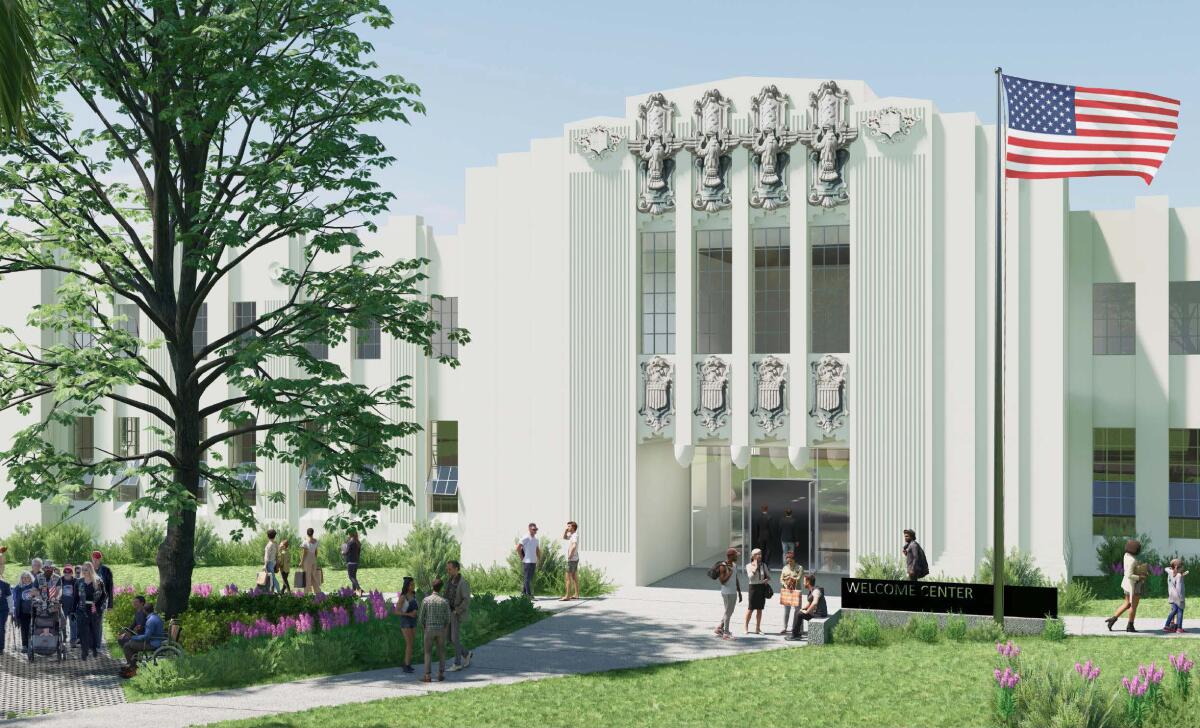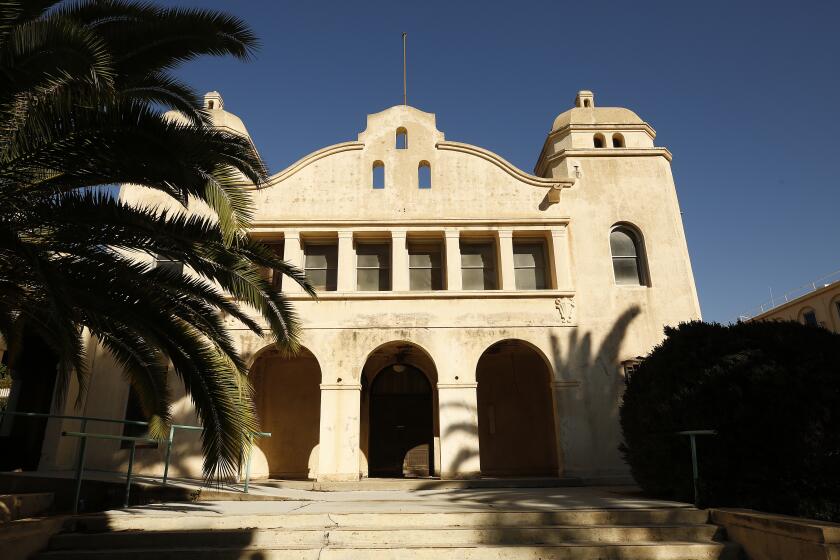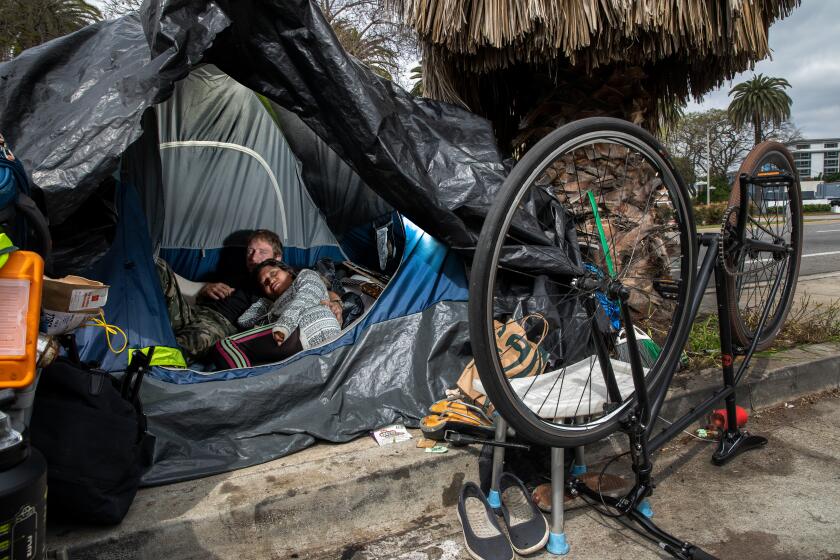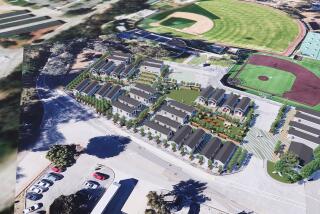Editorial: Vets deserve a thriving town center on revamped West L.A. VA campus

The reimagining of the sprawling West L.A. campus of the U.S. Department of Veterans Affairs is primarily focused on building housing for homeless vets. But that’s not all it’s about.
The 2015 settlement of a lawsuit against the VA led to a pledge to provide at least 1,200 units of housing to homeless veterans. It also spurred the creation of a 2016 master plan to transform the north end of the campus into a community for veterans, with residential buildings surrounding a town center where they can gather, partake in a variety of services, participate in activities or just relax. (The south end of the campus is dominated by the VA medical facilities.)
The housing effort, led by three developers, has finally gained momentum with 237 units opened and most occupied and another 380 under construction or about to break ground. That’s good progress on a daunting task. Now, VA officials must figure out what the town center should look like.
There are conflicts about what that should be. There have already been two versions and much debate over which (if either) of the town center plans better serves veterans who have already started to move into permanent homes on the VA campus as well as veterans throughout the region seeking a place to gather. And although the town center is probably years away from being completed, it’s important for VA officials to get it right by maximizing housing and creating a welcoming communal space that will make it feel more like a hometown than a government facility.
The 2016 master plan featured an oval space that would include a town center with a green space, a town hall, and an array of services, which could include a fitness center, media center, coffee house, shops and legal aid. The idea was to provide the central gathering space — a place that beckoned all vets whether they lived there or not.
The VA is finally making progress on building housing on its West L.A. campus for homeless veterans, but it could still go faster.
The master plan was updated in 2022 with input from architects, VA officials and the principal developers (who came onboard after the first master plan). The town center was reconfigured into a more horizontal space that spreads west from a huge historic building (known as Building 13) anchoring the center with a town hall, restaurant and other uses.
The biggest change to the plan was the addition of four residential buildings to the town center. The amenities and services that had their own buildings in the 2016 plan are now located on the ground floors of residences that provide a total of 316 units. An additional 25 units occupy the second floor of the town hall. Some veterans and advocates are critical of the changes, believing they subjugate the purpose of the town center to the mandate to create housing.
“People don’t heal in housing. They heal in community,” says Jonathan Sherin, the former director of the L.A. County Department of Mental Health who was also an advisor during the 2015 settlement of the lawsuit against the VA.
Anthony Allman, executive director of Vets Advocacy, says the 2022 plan maximizes housing density without looking carefully at what would create the most effective town center.
At least 25 people were relocated from a homeless encampment on San Vicente Boulevard as part of L.A. Mayor Karen Bass’ Inside Safe program.
Of course, veterans don’t want the town center to be an afterthought and neither do we. But the updated version of a town center isn’t an appendage shoehorned into the plan. Quite the opposite. The developers wanted to mix the residential units with other uses on the ground floors to make the town center a hub of activity, said Steve Peck, the chief executive of U.S. VETS, part of the principal developer team, which will develop the town hall. No building would be empty at any time.
For vets, it will feel like a vibrant area. “This is the plan we felt was most conducive to creating that welcoming town center we all wanted,” he said. And the developers were looking for a place to add housing units. “Everyone said the desperate need is housing — build as many units as you can,” Peck said, adding that the number of units now planned is 1,694.
Meanwhile, the VA is taking another look at the town center plans, according to a VA spokesperson. A federal advisory committee that monitors the implementation of the master plan had a number of concerns and recommended the agency get outside assistance defining what a vibrant town center should be. So the VA has hired the Los Angeles chapter of the Urban Land Institute, a nonprofit land use research center, to evaluate the town center. It’s also unclear whether the VA has the authority to let its housing developers build housing along with services for more than just the veterans living there.
It’s smart to get more input from experts. While housing is the most important part of the VA overhaul, turning the campus into a community is something all veterans want, according to advocates for vets and the developers building out the campus.
The town center should be a magnet not just for homeless veterans entering new housing and seeking friendship and the stability of a community, but for all veterans across the region who want to gather, find places to eat, exercise, get legal advice or just stroll through a grassy square.
Housing may be the primary goal of the VA project, but meeting the needs of veterans who long for a community space is the goal. They deserve nothing less.
More to Read
A cure for the common opinion
Get thought-provoking perspectives with our weekly newsletter.
You may occasionally receive promotional content from the Los Angeles Times.











